
|
iCHSTM 2013 Programme • Version 5.3.6, 27 July 2013 • ONLINE (includes late changes)
Index | Paper sessions timetable | Lunch and evening timetable | Main site |

|
iCHSTM 2013 Programme • Version 5.3.6, 27 July 2013 • ONLINE (includes late changes)
Index | Paper sessions timetable | Lunch and evening timetable | Main site |
The decades from the mid-nineteenth century to WWI witnessed unprecedented growth in international communication: it became a commonplace that the world was shrinking, with new perceptions of time and space. Developments in communication—almost entirely based on the circulation of paper—transformed the sciences, bringing together a far-flung community of practitioners from different countries. What was the relation between these newly globalized systems of communication and the making of knowledge?
This symposium (2 x 90 min. slots) will explore the relation between science and paper-based communication from 1848 to 1914. Historians have often assumed that this period’s most significant communications technologies were the telegraph, the telephone and the radio; but for many years these remained relatively insignificant outside high finance and high politics. The principal innovations involved systems for managing paper. This symposium will focus particularly, but not exclusively, on newspapers, periodicals, textbooks and the posting of letters, as vital methods for supporting unprecedented interaction between scientists and their publics in different parts of the world.
The aim for the symposium as a whole will be to focus on exchange, translation and interaction across national and linguistic boundaries; this is in contrast to much work on scientific reception, which tends to juxtapose findings from single countries. How, for example, did scientists benefit from the increasing ease of sending letters abroad? To what extent was the scientific article, as a relatively uniform unit of knowledge, a new development? How was the international network of scientific translations—centred on French, German and English—established and maintained? How did textbook authors, publishers and popular science writers take advantage of the opportunities for multiple markets? What role did newspapers and other periodicals play in recording dispersed or unusual phenomena?
At a broader level, the symposium will explore the relation between the communication systems for science and the political and economic circumstances of this period, particularly colonialism and global trade. Many contemporaries contested the virtues of the new paper-based technological systems, which often pushed out older cultural forms based on oral communication. The circulation of science in print, which was widely seen as the apotheosis of western rationality, had a crucial part to play. And finally, to what extent did the paper-based systems of the long nineteenth century break down as a result of the First World War and decolonisation?

